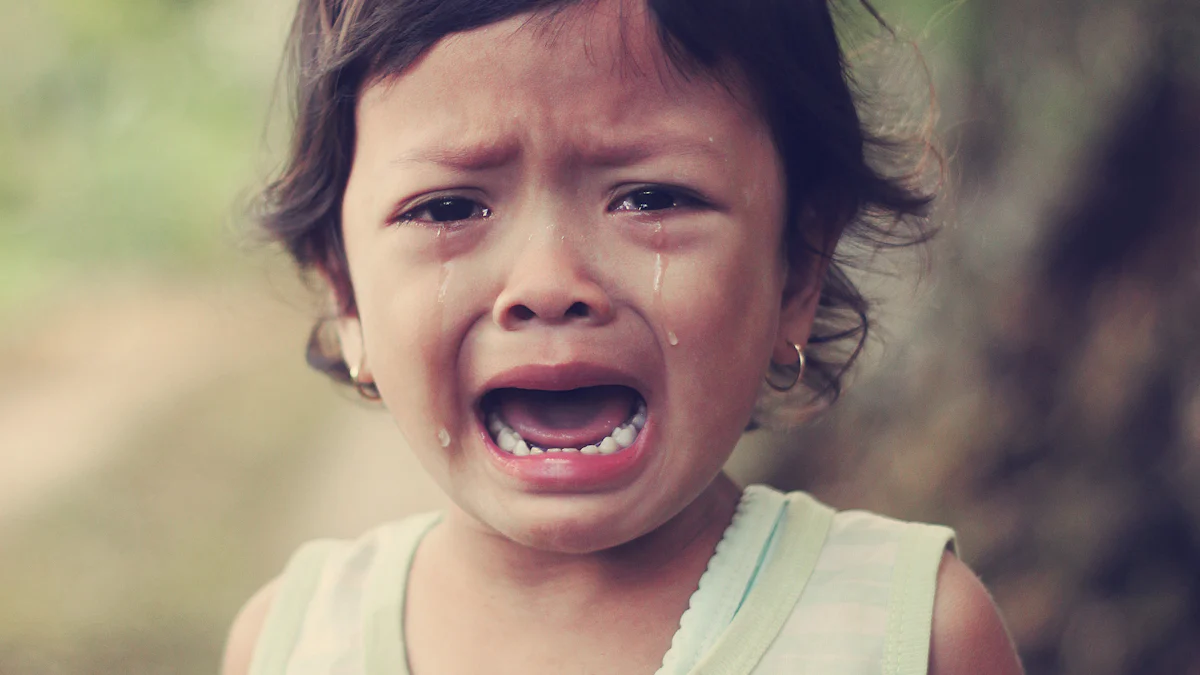Managing Your Child’s Big Emotions in Public Places

Understanding and managing emotions plays a crucial role in parenting. Kids often experience intense feelings, especially in public places. These moments can feel overwhelming. You might wonder how to handle your child’s big emotions when everyone is watching. Dr. Stephanie Margolese, a clinical psychologist, emphasizes the importance of open communication about emotions. Encouraging kids to recognize and express their feelings helps them develop better emotional regulation skills. Navigating these challenges requires patience and empathy. Remember, every parent faces similar struggles. You're not alone on this journey.
Understanding Child’s Big Emotions

What Are Big Emotions?
Big emotions can feel like a whirlwind. Kids often experience these intense feelings in public places. You might notice your child suddenly feeling overwhelmed. Common triggers include loud noises, crowded spaces, or unexpected changes. A child might express big emotions through crying, yelling, or even withdrawing. Recognizing these signs helps you understand what your child feels.
Books like "Storybooks to Help Kids Deal with Big Emotions" offer practical strategies. These stories guide children in recognizing and coping with emotions like sadness and anger. Reading together can provide tools for emotional regulation. This shared activity strengthens your bond with your child.
Why Do They Occur?
Understanding why big emotions occur can help you manage them better. Developmental stages play a significant role. Young children may not have the words to express feelings. This lack of language leads to frustration. Environmental factors also contribute. A busy supermarket or a noisy park can overwhelm a child.
"When Monkey Lost His Smile" focuses on overcoming sadness. The book provides strategies for parents to guide kids through difficult emotions. Another story, "A Spot of Blue," features an owl learning to control anxiety. Visual representations help children let go of worry. These stories offer valuable insights into managing a child's big emotions.
Strategies for Managing Emotions
Spending One-on-One Time
Building a strong connection with your child helps manage your child’s big emotions. Quality time creates trust and understanding. You might wonder how to start. Simple activities can make a difference. Consider reading books like "When Monkey Lost His Smile." This story offers tools for overcoming sadness. Sharing these moments strengthens your bond.
Other activities include playing games or taking walks. These experiences allow open communication. Your child feels heard and valued. This connection builds a foundation for emotional support. Kids feel more secure in public places when they know you’re there for them.
Teaching Emotional Recognition
Identifying emotions is crucial for managing your child’s big emotions. Kids need to know what they feel. Books like "The Tiger in My Chest" help children recognize anger. The story provides practical ideas for control. Understanding emotions leads to better expression.
Using language to express feelings empowers kids. Encourage words over actions. Ask questions like, “What are you feeling?” This approach helps kids articulate emotions. Practice at home prepares them for public situations. Kids learn that expressing feelings is okay.
Validating Feelings
Acknowledgment plays a vital role in managing your child’s big emotions. Kids need to know their feelings matter. Validation shows empathy and understanding. You might say, “I see you’re upset.” This acknowledgment comforts your child.
Techniques for validation include active listening. Pay attention to your child’s words and body language. Respond with care and patience. This approach reassures your child. Kids feel supported and less overwhelmed. Emotional validation fosters a positive environment.
Modeling Behavior
Staying Calm as a Parent
Maintaining your composure during your child's emotional outbursts can feel challenging. You might wonder how to stay calm when emotions run high. Deep breathing exercises offer a simple technique. Inhale slowly, hold for a few seconds, and exhale. This practice helps reduce stress and keeps you grounded. Visualization can also work wonders. Picture a serene place or a calming scene. These mental images can ease tension.
Staying calm positively impacts your child's behavior. Kids often mirror adults' reactions. Your calm demeanor sets an example. Children learn that staying composed is possible even in stressful situations. Remaining calm reassures your child. Your presence provides a sense of security. Kids feel more at ease knowing you handle emotions with grace.
Demonstrating Emotional Regulation
Leading by example plays a crucial role in teaching emotional regulation. Kids watch and learn from your actions. Show them how to manage emotions effectively. Express feelings through words. Say, "I feel frustrated right now." This approach teaches kids to articulate emotions.
Encouraging positive coping mechanisms helps kids handle big emotions. Introduce activities like drawing or journaling. These outlets allow kids to express feelings creatively. Practicing mindfulness together can also benefit both of you. Spend a few minutes focusing on the present moment. Mindfulness fosters emotional awareness and regulation.
Dr. Stephanie Margolese, a clinical psychologist, emphasizes the importance of open communication about emotions. Her work highlights the need for kids to understand and express their feelings. Books like "When Monkey Lost His Smile" offer strategies for managing sadness. These resources guide parents and children through emotional challenges.
Practical Tips for Public Situations

Navigating public places with your child can feel daunting. Big emotions often surface when you least expect them. Preparation and quick thinking can make a world of difference. Let's dive into some practical tips to help manage your child's big emotions in public.
Preparing Beforehand
Preparation sets the stage for smoother outings. Setting clear expectations helps your child know what to anticipate. Explain where you're going and what you'll do. Use simple language that your child understands. This clarity reduces anxiety and helps manage big emotions.
Packing essentials can also prevent potential meltdowns. Bring items that comfort your child, like a favorite toy or snack. These familiar objects provide reassurance in unfamiliar settings. Consider packing a small activity kit. Include coloring books or puzzles to keep your child engaged. A well-prepared bag can be your best ally.
Handling Outbursts
Handling outbursts requires immediate response strategies. Stay calm and composed. Your reaction influences your child's ability to regulate emotions. Use deep breathing techniques to maintain your cool. Encourage your child to breathe deeply too. This shared practice can help diffuse tension.
De-escalation techniques play a crucial role in managing big emotions. Offer choices to your child during an emotional episode. Simple options give them a sense of control. You might ask, "Would you like to sit here or there?" Distraction can also work wonders. Redirect your child's attention to something interesting nearby. Engage them in a different activity to shift focus.
Dr. Margolese, a clinical psychologist, emphasizes the importance of open communication about emotions. Her insights guide parents in helping children recognize and cope with sadness. Understanding these strategies can empower you to handle your child's big emotions effectively.
Encouragement and Support
Building Confidence in Parents
Reassurance and Empathy
Every parent faces challenges with their child's emotions. Feeling overwhelmed is normal. Remember, you're not alone. Many parents share similar experiences. Offering reassurance can make a big difference. Empathy helps you connect with your child. Understanding their feelings builds trust.
Dr. Margolese, a clinical psychologist, emphasizes open communication. Her work encourages families to discuss emotions like sadness. Books like "When Monkey Lost His Smile" provide valuable insights. These resources help normalize emotions for children.
Celebrating Small Victories
Small victories deserve celebration. Each step forward matters. Recognizing progress boosts confidence. Notice when your child manages emotions well. Praise their efforts. Positive reinforcement encourages growth. Acknowledge your own achievements too. Parenting involves learning and adapting. Celebrate your ability to support your child.
Seeking Additional Help
When to Consult Professionals
Sometimes, professional guidance becomes necessary. Recognizing when to seek help is important. Persistent emotional struggles may require expert advice. Consulting a therapist can provide new strategies. Professionals offer tailored support for your child's needs.
Dr. Margolese views books as tools for therapy. Resources like hers complement professional guidance. They promote emotional understanding and regulation.
Resources and Support Groups
Accessing resources strengthens your support network. Books, articles, and online forums offer valuable information. Support groups connect you with other parents. Sharing experiences provides comfort and advice. Learning from others' journeys enriches your own.
Consider exploring resources recommended by professionals. Dr. Margolese highlights the importance of open discussions. Her insights guide families through emotional challenges. Embrace these tools to enhance your parenting journey.
Managing your child's big emotions in public places takes practice and patience. Remember these key strategies:
Spend quality one-on-one time to build a strong connection.
Teach emotional recognition to help your child express feelings.
Validate feelings to show empathy and understanding.
Model calm behavior to set a positive example.
Apply these techniques consistently. Patience and persistence lead to progress. Celebrate small victories along the way. Your efforts make a difference in your child's emotional growth. Keep going, and remember you’re not alone on this journey.
See Also
Supporting Your Child in Managing Anxiety
Promoting Emotional Wellness in Children
Strategies for Dealing with Child Misbehavior

